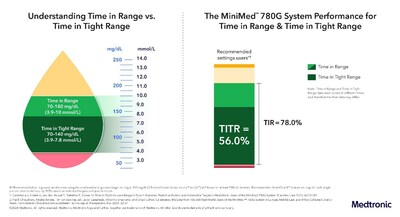New real-world data shows MiniMed™ 780G system sustains strong global performance, exceeding international targets for diabetes management
- None.
- None.
Insights
From an endocrinological perspective, the MiniMed™ 780G system's ability to maintain Time in Tight Range (TITR) above 56% represents a significant advancement in diabetes management. TITR is a more stringent measure than Time in Range (TIR), aiming for glucose levels between 70-140 mg/dL, which is closer to the levels observed in individuals without diabetes. This is crucial because tighter glucose control can potentially reduce the risk of long-term complications associated with type 1 diabetes, such as retinopathy, nephropathy and neuropathy. The data indicating that users can achieve over 80% TIR with optimal settings suggests that the MiniMed™ 780G system could provide a substantial improvement in glycemic control, which is a cornerstone in the prevention of diabetes-related complications.
Furthermore, the reduced frequency of closed loop exits to less than once per week indicates a robust and reliable system that could minimize the daily burden for patients. The high satisfaction scores and quality of life benefits reported are equally important, as patient adherence to diabetes management regimens is often correlated with ease of use and perceived impact on daily living.
From a medical device market perspective, the data presented on the MiniMed™ 780G system could have a substantial impact on Medtronic's market share and competitive positioning. The ability of the device to exceed international glycemic targets and achieve high user satisfaction could drive increased adoption rates among endocrinologists and patients. In the context of the diabetes management devices market, innovation and proven efficacy are key drivers of growth.
The introduction of Advanced Insulin Delivery (AID) systems that leverage powerful algorithms to optimize glycemic control represents a significant technological leap. As Medtronic continues to innovate and demonstrate clinical effectiveness, it could solidify its standing as a leader in the healthcare technology space, potentially influencing investor confidence and stock performance. The emphasis on algorithmic power as a determinant of choice for AID systems highlights the increasing importance of software in medical devices, which could shape future R&D investments and strategic partnerships within the industry.
Examining the economic implications, the MiniMed™ 780G system's effectiveness in managing type 1 diabetes could lead to a reduction in healthcare costs associated with diabetes complications. By achieving greater TITR and TIR percentages, the system may contribute to lowering the incidence of acute events and long-term complications that require hospitalization and chronic care management. This could translate into cost savings for both healthcare systems and patients, while also improving health outcomes.
However, the upfront costs and accessibility of such advanced systems must be considered. The economic impact will be most beneficial if the technology is widely accessible and reimbursed by insurance providers. In the long term, widespread use of highly effective AID systems like the MiniMed™ 780G could shift the economic burden from treatment to prevention, potentially leading to a more sustainable healthcare model for chronic diseases like diabetes.
New data presented at ATTD demonstrates the system's ability to help individuals with type 1 diabetes exceed international targets on outcome measures
New data sought to evaluate the MiniMed™ 780G system's ability to help users achieve Time in Tight Range (TITR) goals, a new and emerging supplementary metric being discussed amongst experts, which more closely mirrors the glucose levels of individuals without diabetes. Also referred to as normoglycemia or euglycemia, it is defined as the percentage of time a person spends in the glucose range of 70-140 mg/dL. TITR lowers the upper threshold of Time in Range from 180 mg/dL to 140 mg/dL. Results showed users (n=13,461) achieved a TITR of greater than
"Since the landmark DCCT study, numerous retrospective studies have demonstrated the association between increased Time in Range and a reduction of diabetic complications.1-12 There's no doubt elevated glucose is harmful and the average blood sugars of those living with type 1 diabetes are higher than we should accept as a clinical community," said Robert Vigersky, MD, Chief Medical Officer, Medtronic Diabetes. "The preponderance of data across randomized controlled trials and real-world studies show that the MiniMed™ 780G system is maximizing Time in Range far surpassing international targets and is taking it a step beyond by getting people closer to euglycemia.13,14 In the absence of a cure, our goal is to relentlessly innovate therapies to help people maximize their health without adding burden, which our newest AID system has proven to do."
MiniMed™ 780G System Early Success in the
In an oral presentation, Dr. James Thrasher, MD, Founder, Arkansas Diabetes and Endocrinology Center, shared data on early real-world users with type 1 diabetes of the MiniMed™ 780G system in the
"The results demonstrate that when the MiniMed™ 780G system is optimized with recommended optimal settings, it helps people with diabetes far exceed the ADA recommended goal of
About Time in Tight Range
The development of continuous glucose monitoring enabled the development of Time in Range (TIR), a metric used today to determine whether an individual with type 1 diabetes is meeting blood sugar management goals. Since 2019, the goal of diabetes management has been to maintain the highest TIR for as long as possible while also minimizing hypoglycemia. The introduction of automated insulin delivery (AID) systems has transformed diabetes care by enabling a wider range of individuals to safely achieve blood-sugar goals with less burden and effort. AID systems are helping people achieve more ambitious goals with glucose management, prompting the emergence of a new supplementary metric that mirrors blood sugar levels of individuals without diabetes (normoglycemia or euglycemia). The MiniMed™ 780G system is demonstrating that a Time in Tight Range above 50 percent is achievable and serves as a powerful tool for those seeking more time in euglycemia.
About the Medtronic Diabetes (www.medtronicdiabetes.com)
Medtronic Diabetes is on a mission to alleviate the burden of diabetes by empowering individuals to live life on their terms, with the most advanced diabetes technology and always-on support when and how they need it. We've pioneered first-of-its-kind innovations for over 40 years and are committed to designing the future of diabetes management through next-generation sensors (CGM), intelligent dosing systems, and the power of data science and AI while always putting the customer experience at the forefront.
About Medtronic
Bold thinking. Bolder actions. We are Medtronic. Medtronic plc, headquartered in
Any forward-looking statements are subject to risks and uncertainties such as those described in Medtronic's periodic reports on file with the Securities and Exchange Commission. Actual results may differ materially from anticipated results.
*Adults, T1 and parents of children with T1 diabetes < 18 years were surveyed; Individual results may vary.
Sources
- Yapanis M, James S, Craig ME, et al. Complications of Diabetes and metrics of glycemic management derived from continuous glucose monitoring. J Clin Endocrinol Metab 2022;107(6):e2221–e2236
- Beck RW, Bergenstal RM, Riddlesworth TD, et al. Validation of time in range as an outcome measure for diabetes clinical trials. Diabetes Care 2019;42(3):400–405
- Lu J, Ma X, Zhou J, et al. Association of time in range, as assessed by continuous glucose monitoring, with diabetic retinopathy in type 2 diabetes. Diabetes Care 2018;41(11):2370–2376
- Raj R, Mishra R, Jha N, et al. Time in range, as measured by continuous glucose monitor, as a predictor of microvascular complications in type 2 diabetes: A systematic review. BMJ Open Diab Res Care 2022;10(1):e002573
- Lu J, Ma X, Shen Y, et al. Time in range is associated with carotid intima-media thickness in type 2 diabetes. Diabetes Technol Ther 2020;22(2):72–78
- Yoo JH, Choi MS, Ahn J, et al. Association between continuous glucose monitoring-derived time in range, other core metrics, and albuminuria in type 2 diabetes. Diabetes Technol Ther 2020;22(10):768–776
- Yang J, Yang X, Zhao D, et al. Association of time in range, as assessed by continuous glucose monitoring, with painful diabetic polyneuropathy. J Diabetes Invest 2021;12(5):828–836
- Hirsch IB, Sherr JL, Hood KK. Connecting the dots: Validation of time in range metrics with microvascular outcomes. Diabetes Care 2019;42(3):345–348
- Mayeda L, Katz R, Ahmad I, et al. Glucose time in range and peripheral neuropathy in type 2 diabetes mellitus and chronic kidney disease. BMJ Open diabetes Res Care 2020;8(1):e000991
- El Malahi A, Van Elsen M, Charleer S, et al. Relationship between time in range, glycemic variability, HbA1c, and complications in adults with type 1 diabetes mellitus. J Clin Endocrinol Metab 2022;107(2):e570–e581
- Beck RW. The association of time in range and diabetic complications: The evidence is strong. Diabetes Technol Ther 2023;25(6):375–377
- Zhu DD, Wu X, Cheng XX, et al. Time in range as a useful marker for evaluating retinal functional changes in diabetic retinopathy patients. Int J Ophthalmol 2023;16(6):915–920
- CGM & Time in Range. American Diabetes Association. Available at: https://diabetes.org/tools-support/devices-technology/cgm-time-in-range. Accessed June 19, 2023.
- American Diabetes Association (2019). Standards of medical care in diabetes—2019. Diabetes Care, 42(Suppl 1): S61-S70.
- MiniMed™ 780G system SSED
- Medtronic data on file: MiniMed™780G users survey conducted in April – May 202in
UK ,Sweden ,Italy ,Netherlands andBelgium . N 789 - dQ&A US Diabetes Patient Panel Report; Customer Overall Satisfaction, n=146; Q4 2023: P.52 (November 2023)
- dQ&A US Diabetes Patient Panel Report; Customer Overall Satisfaction, n=207; Q4 2023: P.85 (November 2023)
Contacts: | |
Ashley Patterson | Ryan Weispfenning |
Public Relations | Investor Relations |
+1-818-576-3025 | +1-763-505-4626 |
![]() View original content to download multimedia:https://www.prnewswire.com/news-releases/new-real-world-data-shows-minimed-780g-system-sustains-strong-global-performance-exceeding-international-targets-for-diabetes-management-302084607.html
View original content to download multimedia:https://www.prnewswire.com/news-releases/new-real-world-data-shows-minimed-780g-system-sustains-strong-global-performance-exceeding-international-targets-for-diabetes-management-302084607.html
SOURCE Medtronic plc









